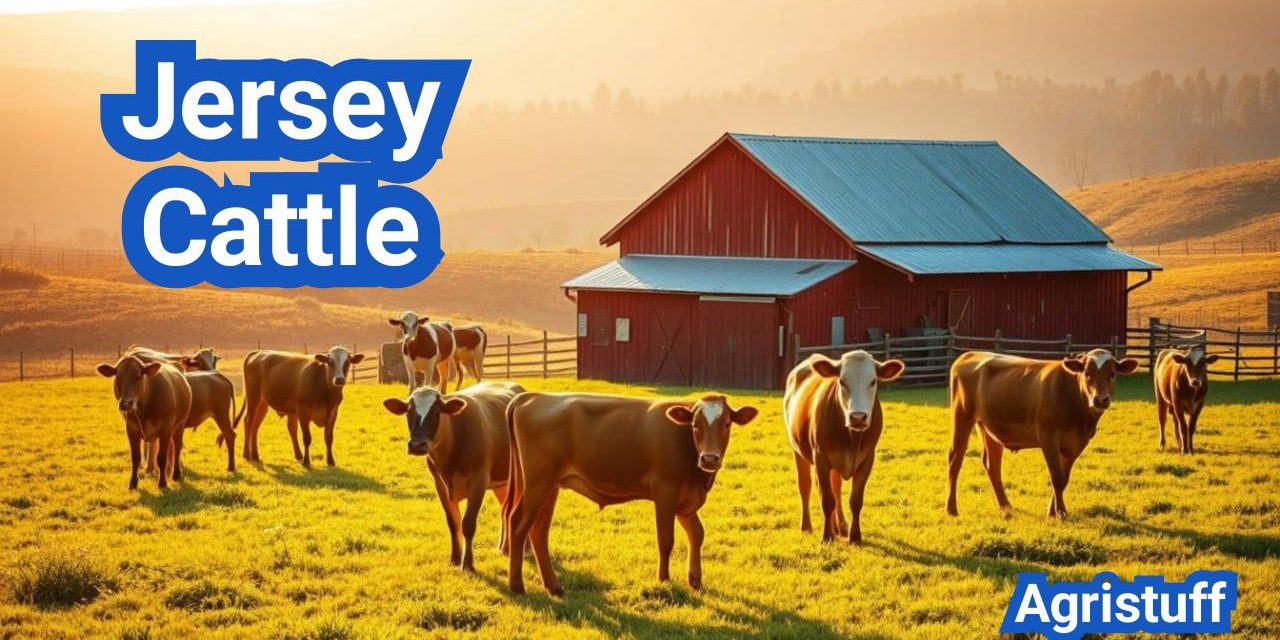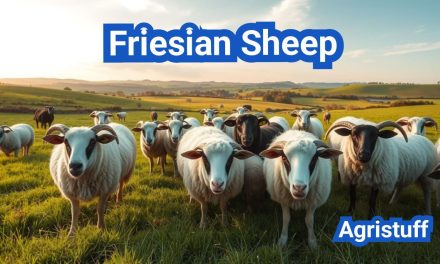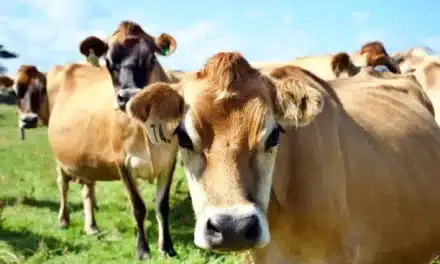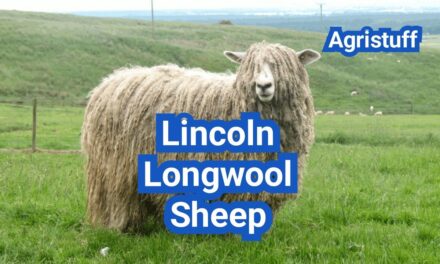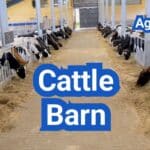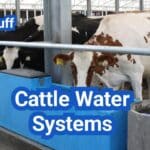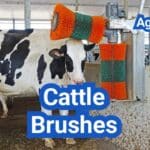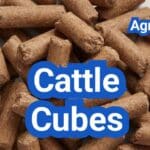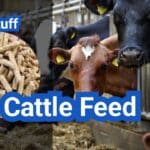Dairy farming is a significant sector in the United States, with various breeds contributing to its success. Among these, Jersey Cattle stand out for their exceptional milk quality and numerous farming benefits.
The Jersey dairy cattle breed is renowned for producing high butterfat milk, making it highly sought after for dairy products. Their milk is rich in nutrients and has a unique composition that is ideal for cheese production and other dairy delights.
By focusing on Jersey Cattle Farming, dairy farmers can capitalize on the breed’s advantages, including their hardiness and efficiency. This not only enhances milk production but also contributes to sustainable livestock farming practices.
Key Takeaways
- Jersey Cattle are prized for their high-quality milk rich in butterfat.
- Their hardiness makes them suitable for various farming conditions.
- Jersey dairy cattle contribute significantly to the dairy farming sector.
- Farming Jersey Cattle can lead to more sustainable dairy practices.
- The breed’s milk is ideal for producing cheese and other dairy products.
The History and Origin of Jersey Cattle
The Jersey cattle breed has a rich history that dates back centuries, originating from the Channel Island of Jersey. For over 200 years, the breed was developed in isolation, protected from external influences, which helped maintain its unique characteristics.
The Channel Island Heritage
The island of Jersey, located in the British Channel, provided a unique environment for the development of the Jersey breed. The island’s rich agricultural history and the careful selection by local farmers contributed to the breed’s distinct features. Jersey cattle were bred for their exceptional milk production capabilities, which remain one of their most valued traits today.
Development of the Jersey Breed Worldwide
As global trade and agricultural practices evolved, the Jersey breed was introduced to new regions. The breed’s adaptability and productivity made it an attractive choice for dairy farmers worldwide. Today, Jersey cattle can be found in many countries, contributing significantly to the global dairy industry.
Jersey Cattle in the United States
The introduction of Jersey cattle to the United States marked a significant milestone in the breed’s global expansion. American dairy farmers recognized the breed’s potential, and it quickly gained popularity. The Jersey breed is now an integral part of the U.S. dairy industry, known for its high-quality milk and efficient production.
Understanding Jersey Cattle Characteristics
Understanding the characteristics of Jersey cattle is essential for appreciating their value in milk production. Jersey cattle are known for their compact size, distinctive color patterns, and robust temperament, making them a unique and valuable breed in the dairy farming industry.
Size and Weight Specifications
Jersey cattle are characterized by their relatively small size compared to other dairy breeds. Adult cows typically weigh between 400 to 500 kg, making them more manageable for smaller farms or those with limited space. This compact size also contributes to their feed efficiency, as they require less feed to maintain their body weight compared to larger breeds.
| Category | Weight Range (kg) | Height Range (cm) |
|---|---|---|
| Cows | 400-500 | 120-130 |
| Bulls | 500-600 | 130-140 |
Distinctive Color Patterns and Features
Jersey cattle are easily recognizable due to their distinctive dark brown or reddish-brown coat color. They often have a lighter-colored saddle area and may exhibit white markings on their face, legs, or belly. Their coat is typically short and fine, requiring minimal grooming. The breed’s distinctive coloration and markings contribute to their visual appeal and can be an asset for farmers looking to create a visually distinctive herd.
Temperament and Behavioral Traits
Jersey cattle are known for their friendly and docile temperament, making them easier to handle, especially for less experienced farmers. They are generally more docile than some other dairy breeds, which can simplify daily management tasks such as milking and veterinary care. Their calm nature also contributes to a more relaxed farm environment, potentially reducing stress among farm staff.
Lifespan and Productive Longevity
Jersey cattle have a relatively long productive lifespan, with many cows remaining in the milking herd for 10 to 12 years or more. Their longevity, combined with their high milk production efficiency, makes them a valuable asset for dairy farmers. Proper care, nutrition, and health management are crucial for maximizing their productive lifespan.
The Superior Milk Quality of Jersey Cows
The milk produced by Jersey cows is considered premium due to its high butterfat content and rich nutritional profile. This makes it highly sought after for producing high-quality dairy products.
High Butterfat Content and Composition
Jersey milk is renowned for its high butterfat content, typically ranging from 4.5% to 5.5%. This characteristic makes it particularly suitable for the production of butter and cheese, as it requires less milk to produce the same amount of product compared to lower butterfat milk.
Protein Levels and Nutritional Profile
Apart from its high butterfat content, Jersey milk is also valued for its protein levels and overall nutritional profile. It contains a rich mix of nutrients, including vitamins and minerals, making it a nutritious choice for consumers.
Flavor Characteristics and Consumer Preferences
The flavor profile of Jersey milk is distinct and rich, often described as creamy and sweet. This unique taste is a result of its composition and is preferred by many consumers who are looking for high-quality dairy products.
Suitability for Cheese and Butter Production
Due to its high butterfat and protein content, Jersey milk is particularly well-suited for cheese and butter production. Dairy farmers and producers favor it for its efficiency and the high quality of the end products.
Jersey Cattle Milk Production Metrics
Understanding the milk production metrics of Jersey cattle is essential for optimizing dairy farm operations. Jersey cows are known for their high milk production relative to their size, making them an efficient choice for dairy farmers.
Average Yield Per Lactation
Jersey cattle are capable of producing between 5,000 to 7,000 liters of milk per year, with some exceptional individuals producing more. This average yield per lactation places Jersey cows among the top dairy breeds in terms of milk production efficiency.
Lactation Curves and Persistence
The lactation curve of Jersey cattle is characterized by a rapid increase in milk production after calving, followed by a gradual decline. Factors such as nutrition, health, and milking practices can influence the shape of the lactation curve and the persistence of milk production.
Comparison with Other Dairy Breeds
When compared to other dairy breeds, Jersey cattle stand out for their high butterfat content and efficient milk production. The following table compares the milk production metrics of Jersey cattle with those of Holstein and Guernsey breeds.
| Breed | Average Milk Yield (liters/year) | Butterfat Content (%) |
|---|---|---|
| Jersey | 5,000 – 7,000 | 5.5 – 6.5 |
| Holstein | 7,000 – 10,000 | 3.5 – 4.5 |
| Guernsey | 4,000 – 6,000 | 4.5 – 5.5 |
Factors Affecting Milk Production
Several factors can affect the milk production of Jersey cattle, including genetics, nutrition, health, and management practices. Ensuring optimal nutrition and health care is crucial for maximizing milk yield and maintaining the overall health of the herd.
By understanding and managing these factors, dairy farmers can optimize the milk production metrics of their Jersey cattle, leading to more efficient and profitable dairy operations.
How to Start a Jersey Cattle Farm

Starting a Jersey cattle farm is a significant undertaking that demands careful consideration of several key factors, including land, housing, and breeding stock. As you embark on this venture, it’s crucial to understand the specific needs of Jersey cattle to ensure the success and profitability of your dairy operation.
Assessing Land and Space Requirements
The first step in establishing a Jersey cattle farm is assessing the land and space available for your operation. Jersey cattle require adequate grazing land and sufficient space for movement to maintain their health and productivity. The land should be well-drained and have suitable pasture for grazing. A general rule of thumb is to allocate about 2-3 acres of good quality pasture per cow, depending on the quality of the forage and the management practices in place.
Designing Appropriate Housing Facilities
Designing appropriate housing facilities is critical for the welfare of your Jersey cattle and the efficiency of your farm. The housing should provide protection from extreme weather conditions, adequate ventilation, and enough space for the cattle to stand, lie down, and move comfortably. Consideration should also be given to the design of the milking parlor, if applicable, to ensure it is efficient and comfortable for both the cows and the milking staff.
Selecting Your Initial Breeding Stock
Selecting high-quality initial breeding stock is fundamental to the success of your Jersey cattle farm. Look for animals that are healthy, well-bred, and have a good genetic background. Consider purchasing from reputable breeders who can provide information on the cattle’s breeding history, health records, and production levels. The quality of your breeding stock will directly impact the productivity and profitability of your farm.
Essential Equipment and Infrastructure
In addition to land, housing, and breeding stock, several pieces of essential equipment and infrastructure are necessary for a Jersey cattle farm. These include milking equipment, feeding systems, manure management facilities, and fencing to ensure the cattle are contained and the pastures are managed effectively. Investing in the right equipment will help streamline your operations and improve the overall efficiency of your farm.
By carefully assessing your land and space requirements, designing appropriate housing facilities, selecting quality breeding stock, and investing in essential equipment and infrastructure, you can establish a thriving Jersey cattle farm that is both productive and profitable.
Daily Management of Jersey Cattle
To maximize the potential of Jersey cattle, farmers must implement efficient daily management practices. Effective daily management involves a combination of routine tasks, best practices, and meticulous record keeping to ensure the health and productivity of the herd.
Establishing Efficient Daily Routines
Establishing a daily routine is crucial for the smooth operation of a Jersey cattle farm. This includes regular feeding times, cleaning of living areas, and monitoring the health of the cattle. Efficient routines help in reducing stress among the cattle, thereby improving their overall well-being and productivity. For instance, a consistent feeding schedule ensures that the cattle receive the necessary nutrients for optimal milk production.
Milking Procedures and Best Practices
Milking is a critical aspect of dairy farming, and for Jersey cattle, it’s essential to follow best practices to maintain milk quality and cow health. Proper milking techniques, including pre-milking preparation and post-milking care, are vital. This includes cleaning the udders, using appropriate milking equipment, and ensuring that the milking area is hygienic. Regular milking not only improves milk quality but also helps in detecting any health issues early.
Record Keeping and Performance Monitoring
Accurate record keeping is fundamental to the successful management of Jersey cattle. Records should include milk production levels, breeding schedules, health issues, and feeding practices. Monitoring performance through these records helps farmers identify areas for improvement and make informed decisions. For example, tracking milk production can help in adjusting feeding strategies to optimize output.
Labor Requirements and Time Management
Managing a Jersey cattle farm requires significant labor and effective time management. Farmers must allocate time for daily chores, milking, and record keeping. Efficient labor management involves training staff and allocating tasks appropriately to ensure that all aspects of farm management are covered. This not only improves productivity but also enhances the overall efficiency of the farm.
By focusing on these aspects of daily management, Jersey cattle farmers can improve the health and productivity of their herds, ultimately leading to a more successful and sustainable farming operation.
Nutrition Management for Optimal Production

Effective nutrition strategies play a vital role in the overall health and productivity of Jersey cattle. Proper nutrition is the cornerstone of a successful dairy farming operation, directly impacting milk quality and quantity.
Formulating Balanced Rations
A balanced ration for Jersey cattle should include the right mix of proteins, carbohydrates, fats, vitamins, and minerals. Nutritional requirements vary based on factors such as age, lactation stage, and production level. For instance, lactating cows require more energy and protein compared to dry cows or heifers.
Formulating rations involves understanding the nutrient content of various feedstuffs and using that information to create a diet that meets the animal’s needs. Regular analysis of feed ingredients is crucial to adjust rations accordingly.
Grazing Systems for Jersey Cattle
Grazing is a natural and cost-effective way to provide Jersey cattle with the nutrients they need. Well-managed grazing systems can enhance milk production while reducing feed costs. The quality and quantity of pasture available can significantly impact the nutritional intake of grazing Jersey cattle.
“Grazing not only provides nutritional benefits but also contributes to the overall welfare of the cattle by allowing them to express natural behaviors.”
Feed Requirements Throughout Life Stages
Jersey cattle have different nutritional needs at various stages of their life cycle. Calves require a diet rich in protein and energy to support growth and development, while mature cows need a balanced diet that supports milk production and maintains their health.
- Calves: High-quality milk replacer or whole milk, followed by a starter feed.
- Heifers: A diet that supports growth without excessive fattening.
- Lactating Cows: Energy and protein-rich diets to support milk production.
- Dry Cows: A maintenance diet that prepares them for the next lactation.
Avoiding Common Nutritional Issues
Nutritional issues such as acidosis, laminitis, and metabolic disorders can arise from improper feeding practices. Monitoring feed intake and adjusting diets as necessary can help prevent these issues. Ensuring access to clean water and providing a balanced diet are fundamental to maintaining the health of Jersey cattle.
By focusing on these aspects of nutrition management, dairy farmers can optimize the production and health of their Jersey cattle, leading to a more sustainable and profitable farming operation.
Jersey Cattle Health Management

Jersey cow health management involves a multi-faceted approach to prevent disease and promote overall health. Effective health management is critical for maintaining the well-being and productivity of Jersey cattle.
Preventative Health Protocols
Preventative health protocols are essential for Jersey cattle health management. These protocols include regular monitoring of the cattle’s health, maintaining a clean and safe living environment, and providing a balanced diet.
- Regular health checks to identify potential issues early
- Maintaining hygiene and cleanliness in living areas
- Providing a nutritious diet tailored to the cattle’s needs
Vaccination and Parasite Control Programs
Vaccination and parasite control programs are vital components of Jersey cattle health management. Vaccinations help protect against diseases, while parasite control measures prevent infestations that can compromise the cattle’s health.
Vaccination strategies should be tailored to the specific needs of the herd and the region.
- Consult with a veterinarian to develop a vaccination program
- Implement parasite control measures such as deworming
- Monitor the herd regularly for signs of disease or parasite infestation
Monitoring and Maintaining Udder Health
Udder health is crucial for milk production and overall Jersey cattle health. Regular monitoring and maintenance are necessary to prevent udder infections and ensure the quality of the milk.
Proper milking techniques and hygiene are essential for maintaining udder health.
- Regularly inspect udders for signs of infection or damage
- Implement proper milking procedures and hygiene practices
- Use milking equipment that is well-maintained and suitable for Jersey cattle
Working with Veterinarians for Optimal Care
Working closely with veterinarians is a key aspect of Jersey cattle health management. Veterinarians can provide expert advice on health issues, develop vaccination programs, and help manage disease outbreaks.
A collaborative approach with veterinarians ensures that Jersey cattle receive optimal care, enhancing their health and productivity.
Breeding and Genetic Improvement Strategies

Breeding and genetic improvement are vital for the productivity and quality of Jersey cattle, involving the selection of superior bulls and the use of artificial insemination.
“The genetic makeup of your herd is the foundation upon which all other management decisions are built,” emphasizes the importance of a well-planned breeding program. Effective breeding strategies can significantly enhance milk production, fertility, and overall herd health.
Selecting Bulls for Desired Traits
Selecting the right bulls is a critical step in any breeding program. For Jersey cattle, desirable traits include high milk production, optimal butterfat content, and robust health characteristics. Genetic testing and evaluation play a crucial role in identifying bulls that can pass on these traits to their offspring.
When choosing a bull, farmers should consider factors such as:
- Proven genetic lineage
- High milk production records
- Resistance to common diseases
- Adaptability to the farm’s specific climate and management conditions
Artificial Insemination Techniques
Artificial insemination (AI) is a powerful tool in modern dairy farming, allowing farmers to access superior genetics from around the world. AI involves the careful selection of semen from high-quality bulls and its precise application to maximize conception rates.
The benefits of AI include:
- Access to a broader gene pool
- Reduced risk of disease transmission
- Improved genetic progress through the use of progeny-tested bulls
Genetic Testing and Evaluation
Genetic testing and evaluation are essential for making informed breeding decisions. By understanding the genetic makeup of both the bulls and the cows, farmers can predict the likelihood of certain traits being passed on to the offspring.
This process involves:
- DNA testing for specific genetic traits
- Genomic evaluations to predict future performance
- Using data to select for desirable characteristics
Managing Your Breeding Calendar
A well-managed breeding calendar is crucial for optimizing reproductive efficiency and ensuring that cows are bred at the optimal time. This involves careful planning and record-keeping to track the reproductive status of each cow.
“A successful breeding program is not just about genetics; it’s also about timing and management,” said a renowned dairy farming expert. Planning the breeding calendar around the farm’s specific needs and conditions can significantly impact the overall success of the breeding program.
By focusing on these key areas, Jersey cattle farmers can develop a robust breeding program that enhances the genetic quality and productivity of their herd.
Jersey Cattle Crossbreeding Benefits

Jersey cattle crossbreeding offers a promising approach to enhancing both dairy and beef production through hybrid vigor. By combining Jersey cattle with other breeds, farmers can capitalize on the strengths of each breed to improve overall productivity and efficiency.
Jersey-Holstein Crosses for Dairy Production
Crossbreeding Jersey cattle with Holsteins is a popular strategy for dairy farmers. Jersey-Holstein crosses benefit from the high milk production of Holsteins and the rich milk composition of Jerseys, resulting in improved dairy production. This crossbreeding approach can lead to increased milk yield with higher butterfat content, making it ideal for producing premium dairy products.
Jersey-Angus and Beef Breed Crosses
For beef production, crossing Jersey cattle with Angus or other beef breeds can enhance the quality and characteristics of the beef. Jersey-Angus crosses combine the hardiness and milk production traits of Jerseys with the beef quality attributes of Angus, potentially leading to more robust and marketable beef cattle.
Hybrid Vigor and Performance Improvements
The concept of hybrid vigor is central to the benefits of crossbreeding Jersey cattle. Hybrid vigor refers to the phenomenon where the offspring of two different breeds exhibit superior traits compared to either parent breed. This can result in improved growth rates, enhanced fertility, and increased resistance to disease, ultimately leading to better overall performance.
Selecting Complementary Breeds
When considering crossbreeding Jersey cattle, it’s crucial to select breeds that complement the strengths and weaknesses of Jerseys. Factors such as production goals, climate, and market demands should guide the choice of complementary breeds. For dairy, Holsteins are a common choice, while for beef, breeds like Angus or Charolais may be preferred.
By carefully planning and executing crossbreeding programs, farmers can harness the benefits of hybrid vigor to improve both dairy and beef production. Whether focusing on dairy with Jersey-Holstein crosses or beef with Jersey-Angus crosses, the potential for enhanced productivity and profitability is significant.
Economic Benefits of Jersey Cattle Farming

The economic advantages of raising Jersey cattle are multifaceted, ranging from feed efficiency to premium milk prices. Jersey cattle farming has gained popularity among dairy farmers due to its potential for high profitability.
Feed Efficiency and Cost Analysis
Jersey cattle are known for their exceptional feed efficiency, converting feed into milk more effectively than many other breeds. This efficiency is largely due to their smaller size and metabolic rate, which results in lower feed costs per unit of milk produced. A study comparing feed efficiency among dairy breeds found that Jerseys require less feed to produce the same amount of milk as larger breeds, making them a cost-effective choice for dairy farmers.
Feed costs are a significant expense in dairy farming, and the ability of Jersey cattle to thrive on less feed can lead to substantial savings. By optimizing feed efficiency, farmers can reduce their overall production costs and improve their bottom line.
Premium Milk Price Advantages
Jersey milk is renowned for its high butterfat content and rich nutritional profile, making it highly sought after by dairy processors. The premium quality of Jersey milk translates into higher prices for farmers, as processors are willing to pay more for milk that is rich in components. This premium pricing is a significant economic benefit for Jersey cattle farmers, as it directly impacts their revenue.
The demand for high-quality milk is on the rise, driven by consumer preferences for rich and creamy dairy products. Jersey cattle farmers are well-positioned to capitalize on this trend, as their milk is naturally suited to producing high-value dairy products.
Lower Maintenance Costs Than Larger Breeds
Jersey cattle generally have lower maintenance costs compared to larger dairy breeds. Their smaller size means they require less space, less feed, and less infrastructure, reducing the overall cost of maintaining a dairy herd. Additionally, Jerseys are known for their hardiness and longevity, which can lead to lower veterinary costs and a longer productive life.
- Reduced feed costs due to smaller size and efficient metabolism
- Lower infrastructure costs due to space requirements
- Potential for lower veterinary costs due to hardiness
Return on Investment Calculations
When evaluating the economic viability of Jersey cattle farming, it’s essential to consider the return on investment (ROI). ROI calculations take into account the initial investment in the herd, ongoing expenses, and revenue generated from milk sales. By comparing these factors, farmers can determine the profitability of their Jersey cattle operation.
A key factor in ROI calculations is the premium price received for Jersey milk, which can significantly boost revenue. Additionally, the lower maintenance costs associated with Jersey cattle can help reduce expenses, further enhancing the overall return on investment.
Marketing Jersey Milk and Value-Added Products

To maximize profits, Jersey cattle farmers must develop a robust marketing strategy for their milk and value-added products. The unique characteristics of Jersey milk, such as its high butterfat content and rich flavor profile, offer opportunities for creating premium dairy products that command higher prices in the market.
Developing Premium Dairy Product Lines
Creating a diverse range of premium dairy products is essential for capitalizing on the superior quality of Jersey milk. This can include artisanal cheeses, rich butter, and high-quality ice cream. By diversifying product lines, farmers can cater to different market segments and increase their revenue streams.
Premium Product Examples:
- Artisanal cheeses (e.g., cheddar, gouda, feta)
- Rich, cultured butter
- High-quality ice cream
- Gourmet yogurt
Direct Marketing Strategies
Direct marketing allows Jersey milk producers to connect directly with consumers, increasing profit margins and building brand loyalty. Strategies include:
- Farmers’ markets
- Community-supported agriculture (CSA) programs
- Online sales platforms
- On-farm retail stores
Direct marketing not only boosts sales but also provides valuable consumer feedback, helping farmers tailor their products to meet market demands.
Building Your Jersey Milk Brand
Establishing a strong brand identity is crucial for differentiating Jersey milk products in a competitive market. This involves creating a compelling brand story, developing a distinctive visual identity, and consistently delivering high-quality products.
Branding Elements:
| Branding Element | Description | Example |
|---|---|---|
| Brand Story | Narrative about the farm’s history and values | “Our farm has been producing Jersey milk for generations, with a commitment to quality and sustainability.” |
| Visual Identity | Logo, color scheme, packaging design | A logo featuring a Jersey cow, with a green and blue color scheme to evoke freshness and nature. |
| Product Quality | Consistency in taste, texture, and nutritional profile | High butterfat content, rich flavor profile |
Pricing Strategies for Maximum Profit
Effective pricing is critical for maximizing profits while remaining competitive. Strategies include premium pricing for high-quality products, value-based pricing, and promotional pricing for special offers.
By implementing these marketing strategies, Jersey milk producers can capitalize on the unique qualities of their milk, differentiate their products, and achieve higher profitability in the dairy market.
Implementing Sustainable Farming Practices

Sustainability in Jersey cattle farming is achieved through a combination of pasture-based management, efficient manure management, and reduced environmental impact. This holistic approach not only enhances the productivity of the farm but also contributes to a healthier environment.
Pasture-Based Management Systems
Pasture-based management is a cornerstone of sustainable Jersey cattle farming. By allowing cattle to graze on pasture, farmers can reduce the need for expensive feed imports and minimize the environmental impact associated with intensive feed production. Rotational grazing is a key strategy, where pastures are divided into smaller sections and cattle are moved regularly to ensure optimal forage utilization and pasture health.
Implementing effective pasture-based management requires careful planning, including soil testing, appropriate fertilization, and monitoring of pasture health. This approach not only improves the nutritional quality of the feed but also enhances biodiversity and soil health.
Reducing Environmental Impact
Jersey cattle farming, like other agricultural activities, has an environmental footprint that can be mitigated through sustainable practices. Reducing greenhouse gas emissions is a critical aspect, achievable through improved manure management, efficient feeding practices, and the use of renewable energy sources on the farm.
Moreover, sustainable farming practices help in preserving natural resources. For instance, maintaining healthy pastures aids in water retention and reduces erosion, while also providing habitat for various wildlife species.
Manure Management and Utilization
Effective manure management is crucial for reducing the environmental impact of Jersey cattle farming. Manure is a valuable resource that can be utilized as fertilizer, reducing the need for synthetic fertilizers and enhancing soil fertility. Proper storage and application techniques are essential to prevent water pollution and minimize odors.
Some farms are also exploring innovative ways to utilize manure, such as anaerobic digestion to produce biogas, which can be used for energy generation, further reducing the farm’s carbon footprint.
Water Conservation Techniques
Water is a precious resource in dairy farming, and its conservation is vital for sustainable Jersey cattle farming. Techniques such as efficient irrigation systems, water recycling, and the use of drought-resistant pasture species can significantly reduce water usage.
Additionally, maintaining healthy pastures through rotational grazing not only improves soil health but also enhances its water retention capacity, reducing the need for irrigation during dry periods.
Mini Jersey Cattle for Small-Scale Farming
The mini Jersey breed is a smaller version of the traditional Jersey cattle, making it ideal for small-scale dairy operations. These compact cattle retain the desirable traits of their larger counterparts, including high milk production and rich milk quality, but require less space and feed.
Characteristics and Size Specifications
Mini Jersey cattle are bred to be smaller, typically weighing between 600 to 800 pounds, compared to the standard Jersey cattle which can weigh between 900 to 1,200 pounds. They maintain the distinctive fawn-colored coat with white markings characteristic of the Jersey breed.
Key Characteristics:
- Smaller stature, ideal for limited spaces
- High milk production relative to their size
- Rich, high-quality milk
- Efficient feed conversion
Space and Feed Requirements
One of the significant advantages of mini Jersey cattle is their reduced requirement for space and feed. They need less acreage for grazing and less feed for maintenance, making them suitable for small farms or homesteads.
| Category | Mini Jersey | Standard Jersey |
|---|---|---|
| Weight (lbs) | 600-800 | 900-1,200 |
| Feed Requirement (per day) | 15-20 lbs | 25-35 lbs |
| Space Requirement (acres) | 1-2 | 2-3 |
Production Expectations and Limitations
While mini Jersey cattle produce less milk than their standard counterparts, their milk is rich in butterfat and protein, making it ideal for cheese and butter production. The average milk production is around 4,000 to 5,000 pounds per lactation.
Production Expectations:
- Milk Production: 4,000 to 5,000 pounds/lactation
- Milk Fat Content: 5-6%
- Protein Content: 3.5-4%
Management Differences from Standard Jerseys
Managing mini Jersey cattle involves similar practices to standard Jerseys, with adjustments for their smaller size. They require regular milking, proper nutrition, and health monitoring. Their smaller size can make handling easier, but they still need regular veterinary care and a well-managed grazing system.
In conclusion, mini Jersey cattle offer a practical solution for small-scale dairy farming, providing high-quality milk with lower space and feed requirements. Their compact size and efficient production make them an attractive option for farmers looking to diversify their dairy operations.
The Future of Jersey Cattle in Modern Dairy Farming
Jersey cattle are poised to play a significant role in modern dairy farming due to their efficiency, milk quality, and adaptability to sustainable practices. As the dairy industry continues to evolve, the benefits of Jersey cattle farming are becoming increasingly evident.
The high butterfat content and rich nutritional profile of Jersey milk make it an ideal choice for premium dairy products, aligning with the growing consumer demand for high-quality dairy. Moreover, the feed efficiency and lower maintenance costs of Jersey cattle contribute to their economic viability in modern dairy farming.
Sustainable dairy farming practices, such as pasture-based management systems, are well-suited to Jersey cattle, enhancing their potential for environmentally friendly production. As dairy farmers look to the future, incorporating Jersey cattle into their operations can be a strategic decision, supporting both profitability and sustainability.
By leveraging the advantages of Jersey cattle, dairy farmers can position themselves for success in a competitive market, capitalizing on the Jersey cattle farming benefits that make this breed an attractive choice for modern dairy farming.
FAQ
What are the benefits of Jersey cattle in dairy farming?
Jersey cattle are known for their high-quality milk, rich in butterfat, and their efficient feed conversion, making them a profitable choice for dairy farmers.
Where did Jersey cattle originate from?
Jersey cattle originated from the Channel Island of Jersey, where they were developed over centuries for their dairy characteristics.
What are the characteristics of Jersey cattle?
Jersey cattle are known for their small to medium size, distinctive fawn or cream-colored coats, and their gentle temperament. They are also known for their high milk production relative to their size.
How does the milk quality of Jersey cows compare to other breeds?
Jersey cow milk is renowned for its high butterfat content, typically ranging between 4.5% to 6%, making it ideal for cheese and butter production.
What is the average milk yield of Jersey cattle per lactation?
The average milk yield of Jersey cattle can vary, but they are known for their consistent production. On average, a Jersey cow can produce around 13,000 to 15,000 pounds of milk per lactation.
How do I start a Jersey cattle farm?
Starting a Jersey cattle farm involves assessing your land, designing appropriate housing, selecting initial breeding stock, and acquiring necessary equipment.
What are the key aspects of daily management for Jersey cattle?
Daily management includes establishing milking routines, record keeping, and monitoring the health and performance of your cattle.
How do I manage the nutrition of my Jersey cattle?
Nutrition management involves formulating balanced diets, implementing grazing systems, and ensuring that nutritional needs are met across different life stages.
What health management practices are essential for Jersey cattle?
Essential health management practices include preventative health protocols, vaccination programs, monitoring udder health, and working closely with veterinarians.
What are the benefits of crossbreeding Jersey cattle?
Crossbreeding Jersey cattle with other breeds, such as Holstein or beef breeds, can improve dairy production, beef quality, and overall hybrid vigor.
What are the economic benefits of raising Jersey cattle?
The economic benefits include feed efficiency, premium milk pricing, lower maintenance costs, and a potentially high return on investment.
How can I market Jersey milk and value-added products effectively?
Effective marketing involves developing premium product lines, direct marketing, building a brand, and implementing pricing strategies.
What sustainable practices can be implemented in Jersey cattle farming?
Sustainable practices include pasture-based management, reducing environmental impact, manure management, and water conservation.
Are mini Jersey cattle suitable for small-scale farming?
Yes, mini Jersey cattle are well-suited for small-scale farming due to their smaller size, lower feed requirements, and manageable production levels.
What are the disadvantages of Jersey cows?
Some disadvantages include their potentially lower milk yield compared to larger breeds and the need for careful management to maintain their health and production.
Why is Jersey cow milk considered better?
Jersey cow milk is considered superior due to its high butterfat content, rich nutritional profile, and suitability for producing high-quality dairy products.
Conclusion of: Jersey Cattle | Milk Quality and Farming Benefits
Jersey cattle are widely celebrated within the dairy farming community, particularly in the United States, for their superior milk quality and significant farming benefits. Originating from the British Channel Island of Jersey, these smaller-sized dairy cattle have become highly sought after due to their milk’s exceptional richness in butterfat and protein. This guide thoroughly covers the distinctive traits of Jersey cattle, their unparalleled milk quality, and their valuable benefits to dairy farmers.
What Are Jersey Cattle?
Jersey cattle are a dairy breed renowned for their high-quality milk production. They are distinguished by their small size, gentle nature, and distinctively fawn-colored coat. Jerseys have earned a prominent reputation for their milk, characterized by high butterfat and protein content, making them ideal for premium dairy products.
Source: American Jersey Cattle Association
Historical Origin of Jersey Cattle
The Jersey cattle breed originated from the Channel Island of Jersey, located off the coast of France. They were selectively bred over hundreds of years to produce high butterfat milk efficiently. Jerseys were introduced to the United States in the early 19th century, quickly becoming popular due to their superior dairy traits.
Source: Oklahoma State University – Jersey Breed
Physical Characteristics of Jersey Cattle
Physically, Jersey cattle are smaller than most dairy breeds, with mature cows typically weighing between 800 to 1,200 pounds. They have delicate, feminine features, a small head, and large expressive eyes. Their coats range from light tan to dark fawn, often with a lighter underbelly.
Source: The Cattle Site – Jersey Breed Profile
Exceptional Milk Quality of Jersey Cattle
Jersey cattle are prized for their exceptional milk quality. Their milk contains higher butterfat (averaging about 5%) and protein content compared to other dairy breeds, making it ideal for producing butter, cheese, yogurt, and ice cream. This richness enhances flavor and adds nutritional value to dairy products.
Source: Dairy Farmers of America
Economic Benefits of Raising Jersey Cattle
Farming with Jersey cattle presents substantial economic benefits, including:
- Premium prices for high-quality milk and dairy products
- Lower feed and maintenance costs due to their smaller size
- Higher efficiency in converting feed to milk
These benefits make Jerseys particularly attractive for dairy farmers seeking profitability.
Nutritional Management of Jersey Cattle
Proper nutritional management is critical for maximizing Jersey cattle milk production. Jerseys require balanced diets rich in energy, protein, vitamins, and minerals. High-quality forage, supplemented with concentrates, ensures optimal milk yield and cow health.
Source: University of Wisconsin Extension
Common Health Considerations in Jersey Cattle
Although Jersey cattle are generally hardy, they can face specific health challenges such as milk fever, ketosis, and mastitis. Effective herd health management, routine veterinary checks, and preventive measures significantly reduce these risks.
Source: Cornell University Dairy Management
Environmental Sustainability with Jersey Cattle
Jersey cattle support environmental sustainability due to their efficient feed utilization and smaller environmental footprint compared to larger dairy breeds. Farms utilizing Jerseys often require less land, water, and resources, promoting sustainable dairy production practices.
Source: Sustainable Agriculture Research and Education (SARE)
Pros of Raising Jersey Cattle
Raising Jersey cattle offers significant advantages:
- High butterfat and protein-rich milk
- Smaller cattle size requiring fewer resources
- Strong market demand for Jersey dairy products
- Excellent fertility and calving ease
These benefits enhance profitability and efficiency in dairy operations.
Source: University of Vermont Extension
Cons of Jersey Cattle Farming
Despite their numerous advantages, raising Jersey cattle presents certain challenges:
- Susceptibility to metabolic diseases like ketosis and milk fever
- Potential for decreased total milk yield compared to larger breeds
- Specific nutritional management requirements
Proper herd management can effectively address these issues, maximizing overall productivity.
Source: Michigan State University Extension
Crossbreeding Benefits Involving Jersey Cattle
Crossbreeding programs often utilize Jersey cattle to improve milk quality traits and feed efficiency. Crosses such as Jersey-Holstein combine Jersey milk richness with Holstein productivity, enhancing profitability and sustainability in dairy farming.
Source: Iowa State University Extension
Final Thought
Jersey cattle represent a valuable investment for dairy farmers due to their unparalleled milk quality, economic efficiency, and environmental sustainability. Although smaller in size, their contributions to dairy farming profitability and sustainable practices are immense. Proper herd management ensures maximum benefits from this remarkable dairy breed.

